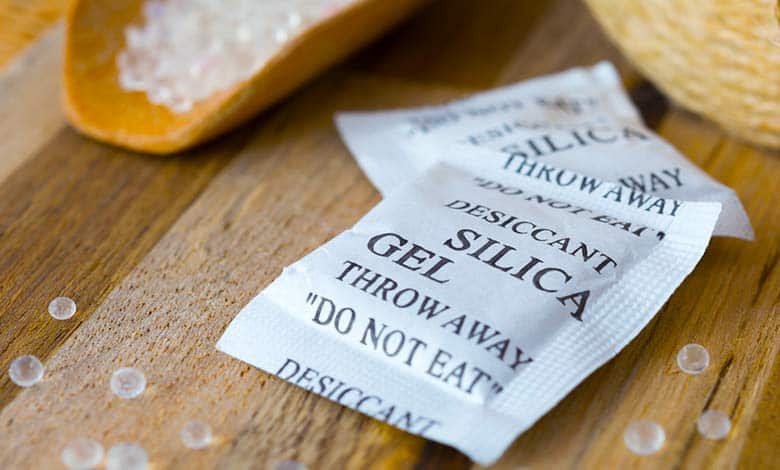
Silica gel is a naturally occurring mineral purified and processed into granular or beaded foam. It is most commonly encountered as beads in a small paper packet. By placing this in the product, moisture is controlled, mold growth is limited, and spoilage is reduced. Since silica gel can have added chemical indicators and absorbs moisture very well, there are a surprising number of users for those tiny packets.
Silica gels are mostly beneficial in anything affected by excess moisture or condensation. It effectively keeps electronic gadgets safe from damaging condensation electronics.
How does silica gel work? (Moisture Protection)
Silica or silicon dioxide is the same stuff as quartz and sand. It’s a desiccant, meaning that it adsorbs and holds water vapor. They deal with moisture pretty interestingly: through adsorption, not absorption. It controls humidity to avoid spoilage or degradation of goods.
- Absorption is when material permeates or is drawn into a substance like a plant and animal cells or the cells in a sponge soak up water.
- Adsorption is when a material sticks to the surface of a substance.
Something adsorbs moisture which means water molecules adhere to the material’s surface. Think of the way that sand can seem to soak up water. The water adheres to the surface of each grain. Silica gel does the same thing. It’s covered in millions of tiny pores that can retain moisture. It can adsorb about 40% of its weight in moisture. This can reduce the relative humidity in a closed container to about 40 percent.
Silica gel is a desiccant that can absorb and hold moisture. It is commonly used in various products and packaging to control humidity, prevent moisture damage, and preserve the quality of goods. Here’s how silica gel works:
Composition: Silica gel is a porous and granular form of silicon dioxide. It is manufactured synthetically from sodium silicate. The gel comprises tiny silica beads with a vast network of interconnected pores.
Adsorption: Silica gel works through adsorption, not to be confused with absorption. When moisture comes into contact with silica gel, the water molecules adhere to the surface of the gel’s pores. This occurs due to the attraction between the water molecules and the polar surface of the silica gel.
Moisture Removal: The air becomes drier as moisture adsorbs onto the silica gel. Silica gel has a high affinity for water, allowing it to adsorb a significant amount of moisture relative to its weight. It can typically adsorb up to 30% of its weight in water, depending on the relative humidity of the environment.
Indication of Saturation: Silica gel comes with an indicator commonly known as a color-changing silica gel. This indicator is usually cobalt chloride or a similar compound that changes color when the silica gel becomes saturated with moisture. The color change serves as a visual indication that the silica gel needs to be replaced or regenerated.
Regeneration: Silica gel can be regenerated and reused by removing the adsorbed moisture. This is typically done by applying heat to the gel, causing the water molecules to evaporate and release from the pores. The regenerated silica gel can then be reused for its moisture-absorbing properties.
Packaging Applications: Silica gel is widely used in various industries for moisture control. It is commonly found in packagings such as electronics, pharmaceuticals, leather goods, and food products to prevent moisture-related damage during storage and transportation. Silica gel packets are included in packages to protect sensitive items from humidity.
Silica gel packs in anything would be affected by excess moisture. It’s in with leather products where it can limit mold growth. You’ll see it packaged with electronics to reduce condensation. As it’s nearly harmless, it prevents spoilage in foods like pepperoni.
Some silica gel pack has a toxic coating of cobalt chloride. Swallowing this stuff probably won’t kill you, but it could cause nausea, vomiting, and other less-than-awesome side effects. But silica gel works pretty well when keeping things dry. It’s also found in vitamin bottles, industrial air systems, and cat litter containers. Also, this stuff is reusable.
You can dry it out by heating it in an oven at about 300 degrees Fahrenheit. That’s about 150 degrees Celsius. People have found all sorts of ways to reuse it. There might be too many to list:
- Protecting papers from humidity.
- Drying flowers.
- Preventing rust on tools.
- Preventing condensation on windows and inside picture frames.
- Preserving art and display cases.
- Mitigating small spills in luggage.
- Slowing silver tarnishing.
- Stopping seed mold.
- Preventing camera lens fogging.
If the beads inside the packet have changed color, they’re oversaturated. So they’ll usually turn from white to yellow, blue to pink, or orange to dark green.
More Articles:
